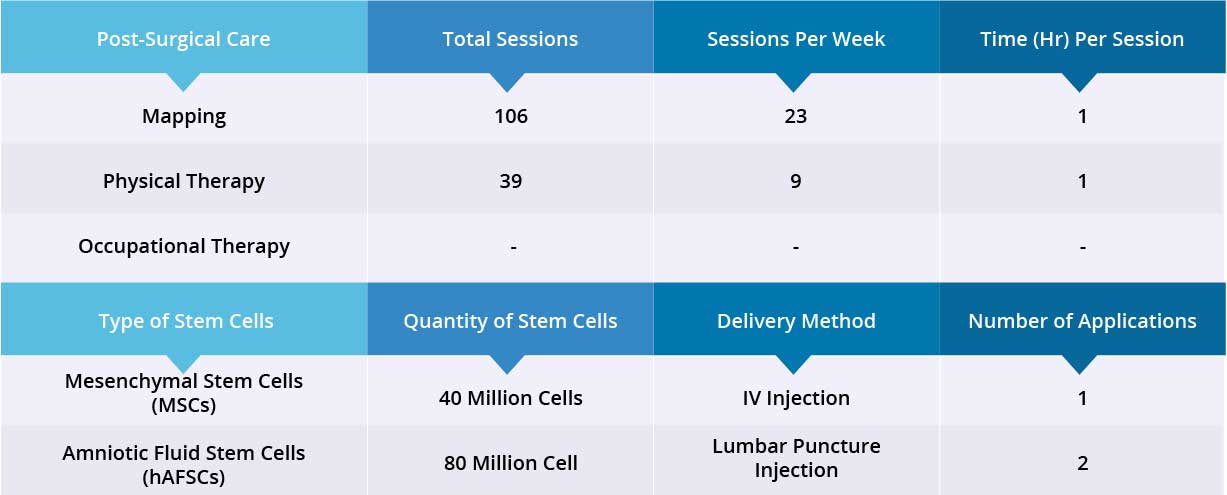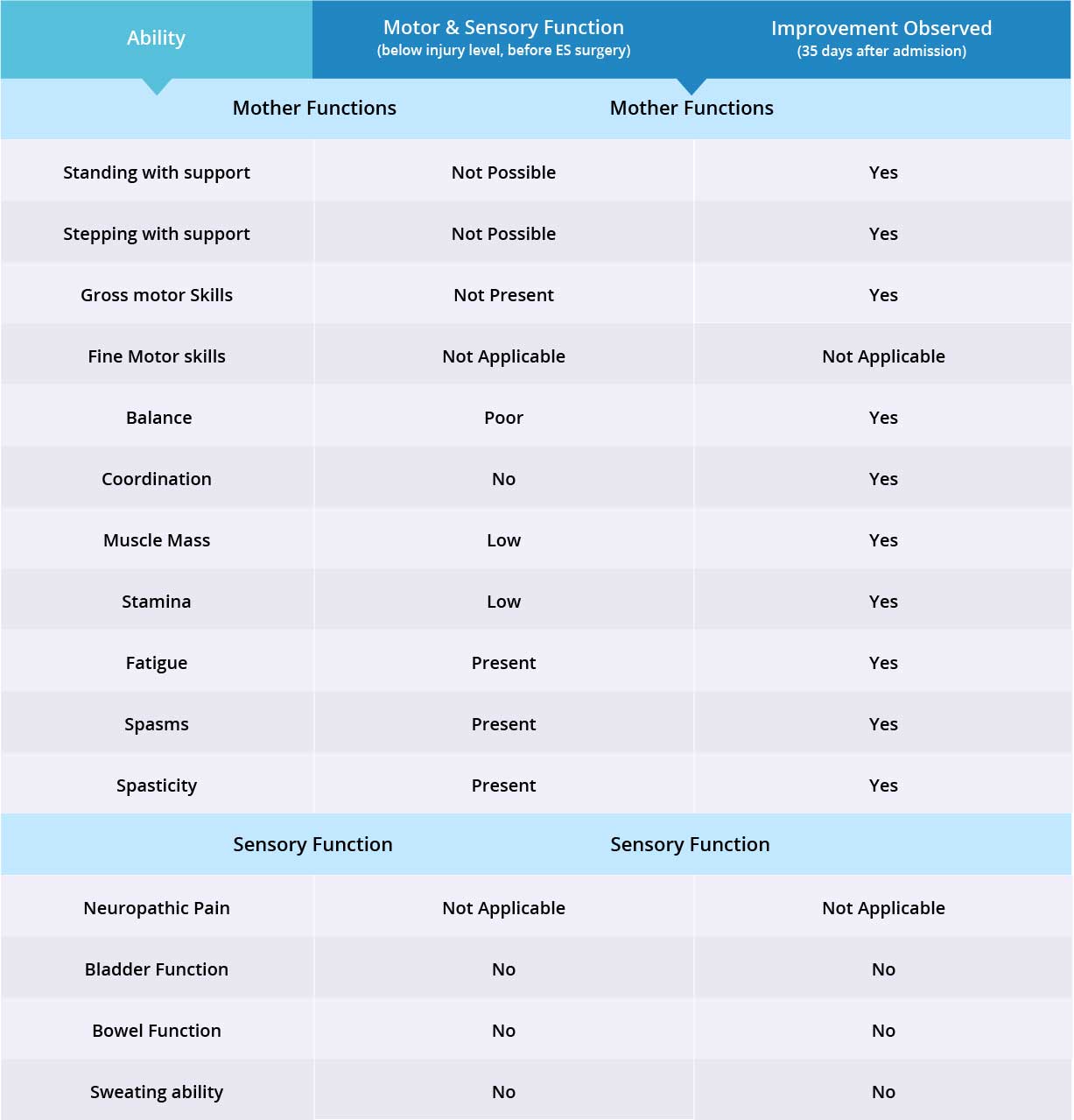Case Study
Patient H,
Male, Pakistani
Table of Contents
Patient Overview
Age at time of treatment: 36 – 45
Injury Level: T6
Treatment Received: Stem Cells, Epidural Stimulation
Location of Treatment: Thailand
Time between injury and treatment: 5 – 15 years
Date of Surgery: 14/04/2018
Date of Discharge: 29/05/2018
Condition on Admission
Patient sustained a gunshot spinal cord injury at the T6 level in 1999. Patient’s MRI scan showed T6 fracture-dislocation with partial spinal cord transection and severe myelomalacia (softening of the spinal cord). Patient has minimal motor or sensory functions below the injury level and suffers from neurogenic bladder and bowel. Patient experiences some spasms and spasticity, but does not suffer from neuropathic pain. Patient is independent in his daily activities.
Previous Therapies & Treatments
Patient has been receiving physiotherapy five times per week, one hour per session.
Patient sustained a gunshot spinal cord injury at the T6 level in 1999. Patient’s MRI scan showed T6 fracture-dislocation with partial spinal cord transection and severe myelomalacia (softening of the spinal cord). Patient has minimal motor or sensory functions below the injury level and suffers from neurogenic bladder and bowel. Patient experiences some spasms and spasticity, but does not suffer from neuropathic pain. Patient is independent in his daily activities.
Verita Neuro Treatment Received
After a spinal MRI scan, an EMG and comprehensive blood work, patient underwent laminectomy and implantation of the epidural stimulation device on April 14, 2018. The device is the ‘Medtronic Restore Advance 16-electrode MRI Compatible Device’. The surgery was completed without significant adverse events and no serious complications were reported during the postoperative hospital stay.
After Epidural Stimulation surgery, patient received 106 Mapping sessions and 39 physical therapy sessions. Patient also received 120 million Amniotic Fluid Stem Cells (hAFSCs): 40 million via one IV injection and 80 million via two lumbar puncture injections. All three applications went well without adverse effects and no short-term or acute complications have been reported.
Device mapping and therapy were carried out after surgery for 35 days, then patient was discharged.

Results
- Motor Functions
- Sensory Functions
- Autonomic Functions
Patient has good static sitting balance and fair dynamic sitting balance, but static standing balance remains poor. Muscle mass and endurance were improved upon discharge.
Patient was able to stand at the parallel bar, but required assistance in locking his knees and hips. He is able to bear weight equally on both legs and has fair trunk control.
Patient is able to lift his legs up to take assisted steps using a walking frame and does not require assistance in foot placement during stepping exercises. Patient has good coordination while taking steps, but did require assistance in locking his knees and hip when stepping.
1 Year Post-Treatment
One year after initial treatment with Verita Neuro, patient has returned and has been participating in 4 to 5 hours of physical therapy per week.
The programs provided by Verita Neuro for gross motor functions have been successful. Patient’s gross motor functions such as flexing and extending his ankles, hips and knees have improved moderately. Patient feels stronger and is able to complete more repetitions kicking and pushing out his legs. On a scale of 1-5, 1 being worse than before surgery and 5 being significantly better, patient rates his gross motor functions as 2.5 to 3.
Patient has noticed significant improvement during standing exercises. He is able to stand up straight and lock both his knees very well. Patient states that he has weak lower back and requires assistance when straightening his spine.
Patient has noticed significant improvement during stepping exercises. He is able to lock both his knees, and keep them locked while taking steps. Patient is able to lift his legs while taking steps and does not require assistance with foot placement. He has good trunk control and is able to bear weight equally on both legs during stepping exercises. Previously, patient was able to take just four steps, but now he can take 10 steps forward, with better coordination than before.
Patient’s static and dynamic standing balance have improved significantly. He is able to stand and move side to side with weights during his physical therapy. He also reports that he can change from a supine position to sitting position with minimal assistance: he requires assistance to move from supine to 45 degrees, then he is able to sit up by himself. Patient was not able to do this during his post-operative therapy. Patient reports an increase in muscle mass, and he feels stronger during therapy sessions. His stamina has improved significantly, and he reports slightly less fatigue.
Overall, patient is very satisfied and would like to return for further stem cell therapy and mapping sessions. He would like to have minor adjustments made to a few of his programs.
1 Year Post-Treatment
Patient has reported increased sensation from his left abdominal area down his left leg. Patient has also regained bladder sensation and control – he is able to hold his bladder contents for longer periods of time. He now only requires a catheter when taking long trips. Patient has noticed very mild improvement in bowel functions. He does not have sensation in his bowel area, but is able to empty his bowel better and faster.

Improvements are monitored in 15 targeted areas: 11 Motor areas and 4 Sensory areas. However, the number of targeted areas may vary depending on patient’s condition prior to admission. If patient does not experience symptoms in certain Motor/Sensory functions, or is not impaired in a specific targeted area prior to surgery, it is excluded from the report (Not Applicable). If there is progress in any given area — either mild, moderate, or significant — it is measured and reported as positive (“Yes”). No improvement, the existence of pain or spasms, or an inability to perform a measured function is reported as “No”.
Results Interpretation
Patient is paraplegic and has normal upper body functions. Therefore fine motor skills were excluded from this report. Motor function improved in 10 out of the 10 targeted areas when the epidural stimulation device was switched on.
Patient does not suffer from neuropathic pain therefore in this case it is considered “not applicable”. Patient has not experienced any improvements in the other sensory function areas, but more feedback will be collected after 3 months to note any improvements made by stem cell treatment. Overall, improvements were recorded in 10 out of 13 targeted motor and sensory function areas.
